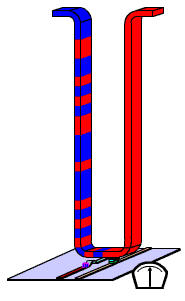IBM's Graphene, Racetrack, Carbon Nanotube Technologies
You can debate Moore's Law back and forth, but it appears that there is always speculation that it will hit a wall eventually.
Innovation is what keeps Moore's Law going and, so far, the semiconductor industry has done an admittedly amazing job to keep it alive. IBM just announced several developments at the IEEE International Electron Devices Meeting, which could support Moore's Law and support its legacy a bit further.
The company announced that it was able to manufacture racetrack memory, graphene-based circuits as well as carbon nanotube transistors on 200 mm wafers for the first time. Racetrack memory combines the capacity of hard drives and the durability and speed of solid state memory and was shown with read and write functionality. IBM said that racetrack memory could enable users to access massive amounts of data within a billionth of a second.
Also on display was the first graphene integrated circuit for wireless communications which can run up at speeds up to 5 GHz and an environment temperature of 200 degrees Celsius (392 degrees F). IBM said that it uses a new architecture that "flips the current graphene transistor structure on its head" and delivers a "high yield" on 200 mm wafers.
According to IBM, it also developed carbon nanotube transistors with sub-10 nm channel lengths, which are capable of outperforming equivalent silicon-based transistors. The company considers this achievement and its implications as "a significant breakthrough for future applications in computing technology."
"Today's breakthroughs challenge the status quo by exploring the boundaries of science and transforming that knowledge into information technology systems that could advance the power and capability of businesses worldwide," said T.C. Chen, vice president, Science and Technology, IBM Research. However, as you may have guessed, there was no information when those inventions will actually be able in products you can buy.
Get Tom's Hardware's best news and in-depth reviews, straight to your inbox.

Douglas Perry was a freelance writer for Tom's Hardware covering semiconductors, storage technology, quantum computing, and processor power delivery. He has authored several books and is currently an editor for The Oregonian/OregonLive.
-
kyuuketsuki alhanelemi cant decide either to upgrade my Core 2 duo now or wait for one of these chipsYou won't be seeing anything from this until 2020 or later, if ever, so...Reply -
spazoid KyuuketsukiYou won't be seeing anything from this until 2020 or later, if ever, so...Reply
I think you might have a bad case of "inability to understand internet sarcasm"!
-
RazorBurn IBM currently holds the largest Patents the tech industry..Reply
In 2010, IBM became the first company to be granted more than 5,000 U.S. patents in a single year. IBM racked up 5,896 patents, a gain of 20 percent from 4,914 patents in 2009.
2010 U.S. Patent Leaders*
1. IBM - 5,896
2. Samsung - 4,551
3. Microsoft - 3,094
4. Canon - 2,552
5. Panasonic - 2,482
6. Toshiba - 2,246
7. Sony - 2,150
8. Intel - 1,653
9. LG Electronics - 1,490
10. HP - 1,480
I doubt anyone would want to sue IBM for any patents.. -
RazorBurn I didn't see Apple in my last post of the TOP TEN.. Yet their are the biggest Patent Troll ive seen..Reply -
theuniquegamer I think we can have a storage which is combination of speed of ssd at price and capacity of hdd by the graphene circuits in the future.Reply -
ojas Gotta love IBM, they've been doing it for a hundred years and just keep going at it. Good work, i hope these make it into production soon. Go innovation!Reply
RazorBurnI didn't see Apple in my last post of the TOP TEN.. Yet their are the biggest Patent Troll ive seen..Yeah because they probably don't have more than 5, which they misuse all the time. One for the shape of the ipad, one for the ipod's wheel (i know it's not used now), one for the nano's size, one for the iMac not being a PC (or maybe Steve Woz has that) and one for the extremely overpriced screen. Then i heard that the AC/DC adapter that macbooks use (yes, that white square) was patented by jobs. likewise, rest of the IP probably belongs to jobs and woz.
Oh, almost forgot, probably own the copyright to the statement "you're holding it wrong" as well...but that's not a patent so no points there! :P
